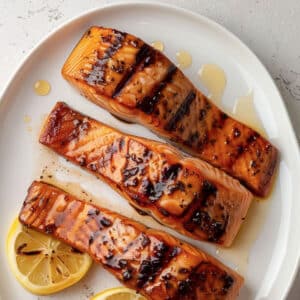Difference between brine and marinade. Brining is an excellent way of adding moisture to the meat. Marinating is another great way of adding moisture, but it also adds flavor.
If you'd like to know more about both processes and which to use when you've come to the right place. Knowing the ins and outs is important because they are not interchangeable. To find out more, please read on.
Jump to:
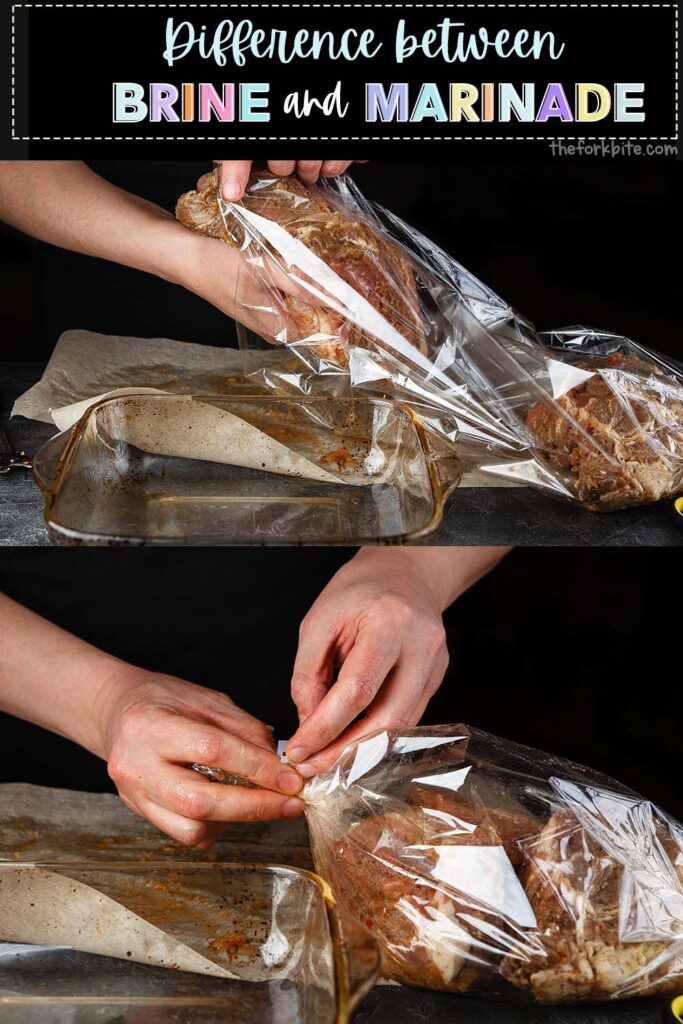
What is the difference between brine and marinade?
Brine and marinade are both liquids used to flavor food but they have different purposes and effects. Brine is a saltwater solution that is used for pickling or preserving food. The high concentration of salt in brine inhibits the growth of bacteria, keeping the food fresh for longer.
Conversely, we used marinade to tenderize and flavor meat, fish, or vegetables. It typically contains acid (such as vinegar or lemon juice), oil, and spices. The acid in marinade breaks down the tough fibers in meat, making it more tender. Both brine and marinade can enhance the flavor of food, but they should not be confused.
1 The similarity between brine and marinade
Marinating and brining are similar in that you coat the meat in a liquid concoction with both processes.
Then leave it to soak for several minutes or hours, depending on the recipe you are following. It is the same principle whether you use a thin brine solution or a thicker marinade mixture.
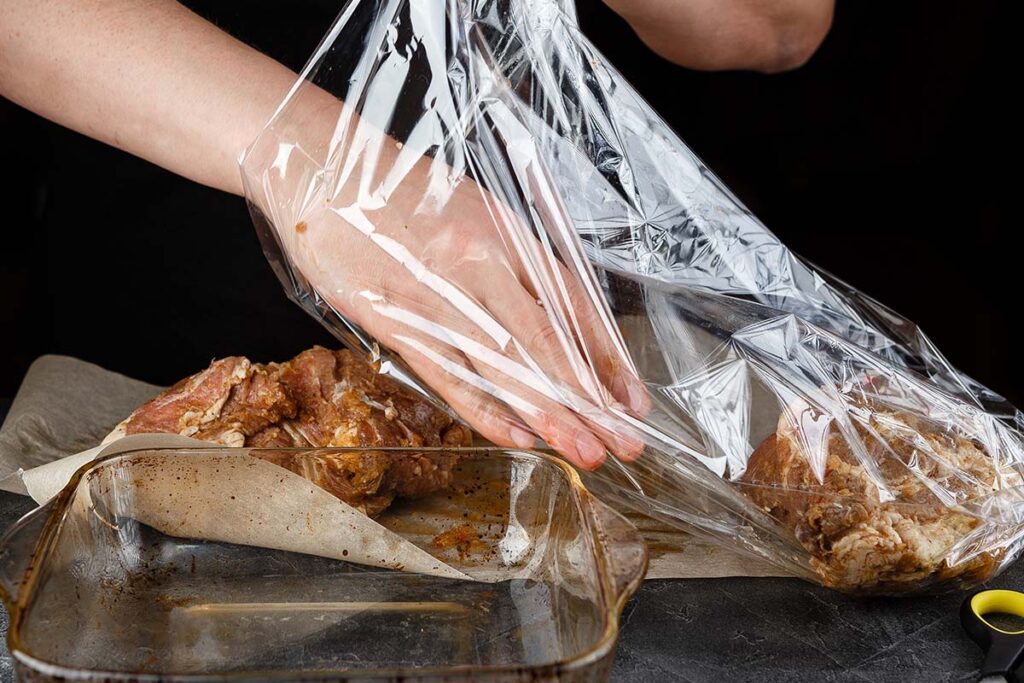
2 Moisture versus flavor
To fully appreciate the differences between the two procedures, we must delve into each further.
How marinades work
I've explained that the task of a marinade is to add flavor to the meat rather than just moisture, which is the main work of a brine.
When you pour a marinade over the meat, it is not supposed to penetrate more than a few millimeters.
Some cooks are under the misapprehension that marinating meat tenderizes it. It does not. If anything, it does slightly the opposite, according to this website.
The misapprehension is born from the fact that the acids in a marinade do bring about changes in the meat, but those changes are not to tenderize it - rather, they are to make it more firm - not tougher - firmer.
Fish Ceviche is a perfect example.
How brines work
Brining meat is about keeping it moist as it cooks, no matter how long (within reason) it is cooked. It can also add flavor, but that is not its primary objective.
3 Brining is a longer process than marinating.
Having established that brining encourages meat to absorb liquid, it makes sense that it will take longer than marinating, whose purpose is to inject a flavor kick just a few millimeters below the meat's outer surface.
Getting meat to absorb the brine to the point of saturation takes much longer than quick marination when it replaces the water. It is not just the absorption time to consider; it also takes time to tenderize the meat.
- Brining meat can lose some flavors as it soaks in the brine and loses some of its natural water. Some of the flavors leak away into the water.
- One way to combat this taste loss is to make gravy or sauce or to flavor the brine.
What is Brine?
Brine is a salt-based liquid that you can add to large chunks of meat to make them juicier. The idea is to prevent the meat from drying out too much as it cooks.
At its most basic, brine is water and salt. However, you can add other flavorings such as cinnamon, peppercorns, sugar, or other spices. The underlying principle of brining is osmosis.

How do you make a brine?
A brine is a saltwater solution used to pickle vegetables or preserve meats. The high concentration of salt in the brine creates an environment that is hostile to bacteria, preventing spoilage and extending food's shelf life.
Making a brine is a simple process that only requires a few ingredients.
Brine basic ingredients:
- 1 cup of salt
- 1 gallon of water
Optional ingredients:
- ½ cup of sugar
- 2 bay leaves
- 1 tablespoon of black peppercorns
- 1 tablespoon of whole allspice berries (optional)
- 5 cloves of garlic
Instructions:
1. Combine salt, sugar, and water in a large pot.
2. Add bay leaves, black peppercorns, allspice berries, and garlic.
3. Bring the mixture to a boil, stirring until the salt and sugar dissolve.
4. Remove the pot from heat and let the mixture cool to room temperature.
5. Once cooled, transfer the brine to a large container with a lid.
6. Add your food item to the brine, ensuring it is fully submerged.
7. Cover the container and store it in the fridge for at least 24 hours.
Why do you brine before cooking?
Brining meat was a common practice before refrigerators became commercially available.
Today, even though most homes have a fridge, there are two main reasons why cooks still brine their meat to improve or preserve flavor and texture.
Brining meat with flavored brine infuses it with different taste notes simultaneously, making it more tender. Even basic brine can enhance flavor due to the salt it contains.
What are some benefits of using a brine?
When it comes to cooking, there are a lot of different techniques that you can use to make food taste great. One of the most effective methods is to use a brine. Brining is a process of soaking meat or vegetables in a salty solution, which helps to break down the tough fibers and add flavor.
Whether you're cooking a holiday turkey or making a weeknight dinner, using brine is an easy way to improve the taste and texture of your food. Additionally, brining can help to prevent food from drying out during cooking. As a result, dishes prepared with brine are often more moist and flavorful than those not.
How does it work?
The science behind brining is based on osmosis. According to Future-Learn.com, osmosis is when water molecules travel from an area with a higher concentration of water molecules to an area with a lower concentration by passing through the partially permeable membrane of a cell.
Enough of this technical jargon.
Simple English means that the brine will be drawn into the meat. When meat is first soaked in a brine solution, the water in the meat's cells transfers from the cells into the brine.
This is how brining works
As a result, the saltiness of the brine is diluted. When the respective concentrations of salted water swap over, the brine, which received water from the meat, travels back into the meat, taking its salt and any leaked flavor with it.
The result is nice, slightly salted, extra moist meat that hasn't suffered too much flavor loss and will remain moist as it cooks.
Because the meat now has all that extra moisture trapped inside, even though it will lose the same amount of water during cooking that it would have lost before in infusion, it will still be lovely and juicy.
As culinary king and science geek Harold McGee said, it is one rare occasion when the old enemy of water retention works for us rather than against us.
- When meat is brined, it takes on more liquid and salt, which then proceeds to break down the proteins of the meat.
- If you imagine the proteins of meat to be tightly wound coils, the salt allows them to relax. The result is meat that feels more tender in the mouth and has less chewiness.
If you check out this episode of Good Eats, you'll find a nice, easy explanation about brines and their work.
But were you aware that you can dry and wet brine?
Dry brine vs wet brine
Whether we are talking dry or wet brining, they both work the same way - they infuse salt into the meat.
As briefly explained above, the salt breaks down the meat's muscle proteins allowing the water to be absorbed into said muscles.
If we make a roast turkey as an example, thanks to the fact that the salt has destroyed the bird's protein strands, its muscles can no longer contract. It minimizes the amount of liquid the bird loses during cooking, helping it retain moisture and giving you a lovely juicy, succulent turkey.
Let's now take a look at wet and dry brine in action, starting with wet.
1 Wet brine
We've already discussed how wet brining saturates meat. The amount of brine that is absorbed increases the content of the meat by 40%., much of which is retained during cooking.
It's why you don't see rivers of water leaking from the meat as it cooks.
2 Dry brine
Dry brine does the same thing as wet. It draws the natural moisture of the meat out and mixes it with the salt on the outside surface of the meat, which then gets re-absorbed back inside.
The resulting brine that is re-absorbed is more concentrated and also breaks down the muscle proteins, stopping them from losing too much liquid as the meat cooks.
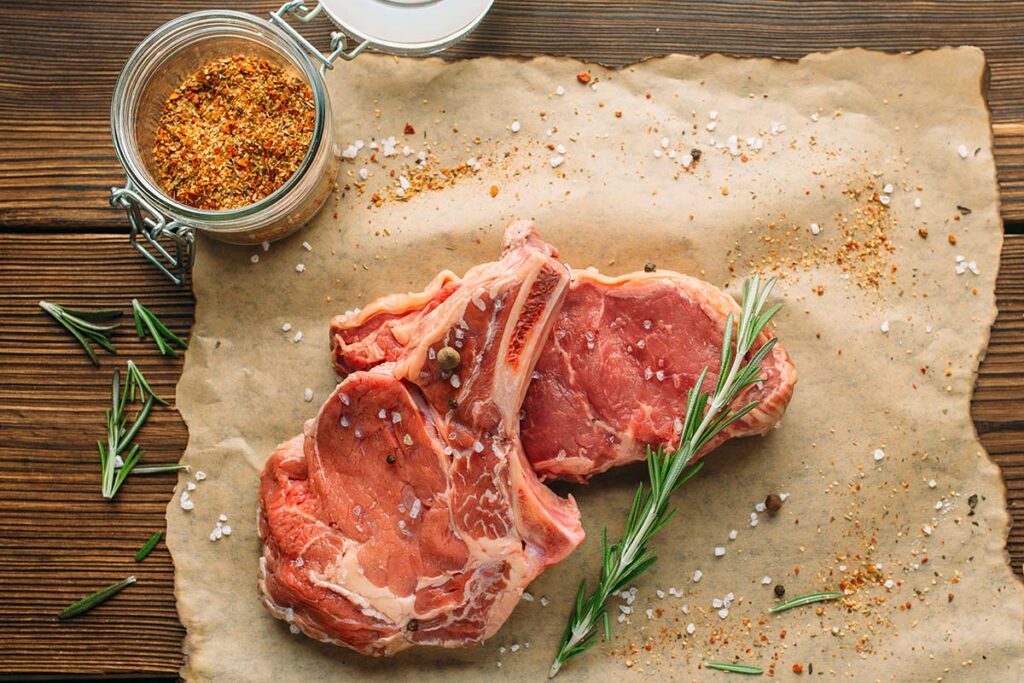
- The magic ingredient with both wet and dry brining is coarse salt. You can add other flavors, such as sugar, spices, and citrus zest, but they neither hinder nor help the osmosis process.
Likely, you wouldn't even taste them following a wet brining. However, with dry brining, any flavorings are in direct contact with the outer flesh or skin, which means they can be easily absorbed into the meat, giving it more flavor.
How to wet brine meat?
1 The basic principle for any wet brine solution begins with one cup of salt (Kosher if you are Jewish) to one gallon of water. Ensure that you dissolve the salt before you immerse the meat.
2 You can add a few smashed cloves of garlic, black peppercorns, crushed citrus fruit, and honey or brown sugar for additional flavorings.
3 You can try using apple juice if you prefer, rather than water. It will give any poultry a slightly sweet autumnal type of flavor.
Pro tip:
If the meat you are brining has skin (for example, chicken or turkey), after draining it, pat it down with some paper kitchen towel and pop it into your fridge to sit for a few hours before cooking.
Once cooked, the meat will be succulent and tender, and the skin will be a lovely golden brown and incredibly crispy.
How to dry brine meat?
Although it's stating the obvious, dry brining doesn't require any water.
As there is no osmosis to transfer the dry brine into the meat, the spices must sit on the outside of the joint long enough to allow the flavors to infuse.
1 You must allow for one teaspoon of salt per two pounds of meat, plus any other flavorings you intend to add.
2 Work the dry brine vigorously into the meat until it is completely covered.
3 Once done, place the meat into a plastic bag (a large Ziploc bag will do nicely) and let it stand for 24 hours or more.
4 Whereas with wet brining you can ruin the meat if you leave it in the solution for too long; that is not the case with dry brining.
However, you don't want to leave the meat brining for too long, or it could start to go off. I wouldn't recommend allowing it to dry brine for three days, tops.
5 There is another way of dry brining whereby you transfer the meat (uncovered) into your fridge and leave it there for between one and 3 three days.
6 Whenever I use this method, I transfer the coated meat onto a wire rack, set it in a tray lined with foil, and place it in the fridge.
Helpful tip:
You’ll find that adding a small pinch or two of sugar to your brine mixture will encourage the meat to caramelize while cooking.
When should you use a brine?
A brine is a saltwater solution used for preserving food. The high concentration of salt in the brine inhibits the growth of bacteria, which would otherwise cause the food to spoil. Brining is an effective way to extend the shelf life of meat, poultry, and fish. It is also commonly used to pickle vegetables.
Brining also has the effect of tenderizing meat, as the salt helps to break down the proteins in the muscle tissue. As a result, food that has been brined will be tastier and more succulent than food that has not.
There are two main types of brining: wet brining and dry brining.
Wet brining involves submerging the food in the saltwater solution, while dry brining involves rubbing the food with salt and allowing it to air-dry. Both methods effectively preserve food, but wet brining is generally preferable.
Wet brining allows the salt to penetrate deep into the flesh of the food, resulting in better flavor and texture. On the other hand, dry brining can sometimes result in a salty crust forming outside the food.
For this reason, wet brining is generally preferable for most meats and fish. When preserving food, a little salt can go a long way. Using a simple brine solution, you can keep your food fresh for longer and enjoy tastier meals.
So when should you use a brine?
You can use brine to preserve all kinds of food, but it is especially well-suited for meat and fish. The salty water helps keep the meat moist and flavorful and helps prevent it from drying out during cooking.
In addition, you can use brine to pickle vegetables such as cucumbers and onions. The pickling process not only preserves the vegetables but also gives them a unique flavor that is perfect for salads and sandwiches.
Tips when brining meat:
- The most important thing to remember when making brine is to use a non-reactive container, such as glass or stainless steel. Reactive containers, such as aluminum, can leach harmful chemicals into the brine.
- Once you have prepared your brine, submerge the food in the solution and store it in the refrigerator. For best results, allow the food to brine for at least 12 hours before cooking or consuming. In addition, be sure to use kosher or pickling salt, as regular table salt may contain additives that can give the brine a cloudy appearance.
How long should you leave food in a brine
When it comes to food safety, there are a lot of old wives' tales and urban legends out there. But when it comes to brining, there is a definite science to it. Brining is the process of submerging food in a saltwater solution.
This helps to tenderize the food and keep it moist during cooking. However, leaving the food in the brine for too long can start to break down and become mushy.
So how do you know how long to leave food in a brine?
The amount of time you should leave food in a brine depends on the type of food, the size of the food, and the strength of the brine. For example, chicken breasts will only need to be brined for a few hours, while a whole turkey may need to be brined for 24 hours or more.
Generally, it is safe to leave food in brine for up to 12 hours. However, if you plan to leave the food in the brine for longer than that, it is vital to use a weaker brine solution to prevent the food from becoming mushy.
Which types of meat benefit from brining?
Not all meats are the same. When brining, this has to be considered because they differ in structure (texture, density, and moisture). Don't forget that the basic reason for brine in the first place is to help the meat retain moisture and infuse a bit of additional flavor, perhaps.
It means that meats that are not particularly moist benefit most. Any fat on or in the meat should be left because it melts during cooking, helping to keep the meat nice and moist.
It's one of the reasons that ribeye steak is so succulent. Meats that don't have a lot of fat are prime candidates for brine.
1 Poultry
Poultry is a perfect example of meats that benefit from brining. A large chicken or turkey can take quite a while to cook, especially when stuffed. It's also easy to lose a lot of moisture during the cooking process. Brining will help to prevent that.
2 Big slices of meat
The types of meat that benefit most from brine are those that are leaner and have less fat. Because of this, they tend to dry out during cooking and lose flavor.
Some meats fare better from brining than others. These include pork chops, loin, tenderloin, and racks of ribs—large joints of meat such as pork leg or shoulder benefit particularly well from brining.
Bear in mind that larger cuts of meat tend to take longer to season thoroughly, don't run out of time. Plan ahead.
Meats with more fat, such as beef and lamb, are not the best candidates for brine due to the extra fat. The fat means they already have the extra moisture they need, and as the fat cooks, it infuses the meat with more flavor. So you end up with a succulent, tasty piece of meat without having to brine it.
Note: When buying a joint of meat for brining, it's good to check the label to ensure that it hasn't previously been injected with a saline solution.
More helpful brining tips
1 When brining, you need to consider food health and safety. You don't want to encourage nasty bacteria like Salmonella, so it's essential to allow the brining in your fridge.
2 It is also a good idea to ensure your meat is not exposed directly to the air. If it is, it can heighten the chances of bacterial contamination.
3 It would be best always to allow refrigerated meat to reach room temperature before you start cooking it because it will help ensure it cooks evenly and remains tender.
4 Last but not least, a quick reminder to pat a wet brined turkey dry with a paper kitchen towel before placing it into the oven. It will give you gorgeously crisp skin.
How long does it take to brine meat?
The length of time it takes to brine a piece of meat completely depends on the meat's size. The larger and denser it is, the longer it will need to be left to soak and adequately infuse the flavorings and seasonings.
As a general guide, you should wet brine meat for approximately one hour for every pound of flesh. Although it's possible to over-soak the meat, people tend to do the opposite and under-soak it.
For best results, you should keep it close to the guideline mentioned earlier. However, remember that one hour per pound is a generalization.
Various types of meat and how it affects the brining time.
1 Brining chicken and seafood
These types of meat are significantly less dense than meat like beef, lamb, and pork, so generally, they will need less time to wet brine.
If you brine a whole chicken, you can stick to the one-hour per one-pound guideline. Since these meats are so much less dense, they will need less time soaking. A whole chicken can follow the "hour-per-pound" rule.
Shrimp will never take more than an hour to brine, regardless of how many you are brining. Because they are small and separate, they only take minutes to brine.
2 Brining pork
If you brine a whole pork loin or shoulder, you must allow it to soak for at least 12 hours. Because the meat is so dense, you need to allow enough time for the brine to work its infusion magic.
A quick brine is not really worth it.
If I got home from work and forgot to brine the pork in the morning, I wouldn't bother to start it so late. It won't have the desired effect. But whereas under brining is not very effective, you can go over brine, providing you don't overdo it.
Leaving it for half again, as long as you originally intended, won't do any harm. If anything, it will make the meat nice and juicy, and flavorsome.
There is a handy guide on how long to wet brine various meat, fish, and poultry on the MSN.food website. Click here to access.
What is marinade?
We already know we brine to add moisture to the meat while we marinade, intending to add flavor.
Marinades usually contain some acid, which, as you now know, helps to break down proteins and readies the meat for infusing with more flavor.
The type of acid with talking about comes from things like citrus, vinegar, and wine.
But the same can't be said for over-marinating, whereas you can leave the meat in a wet brine for considerably longer than you intended without seriously harming its texture. If you let the meat marinate for too long, it will become mushy, which is not nice.
Don't forget to pop your marinating meat into the fridge. You want to keep any harmful bacteria at bay.
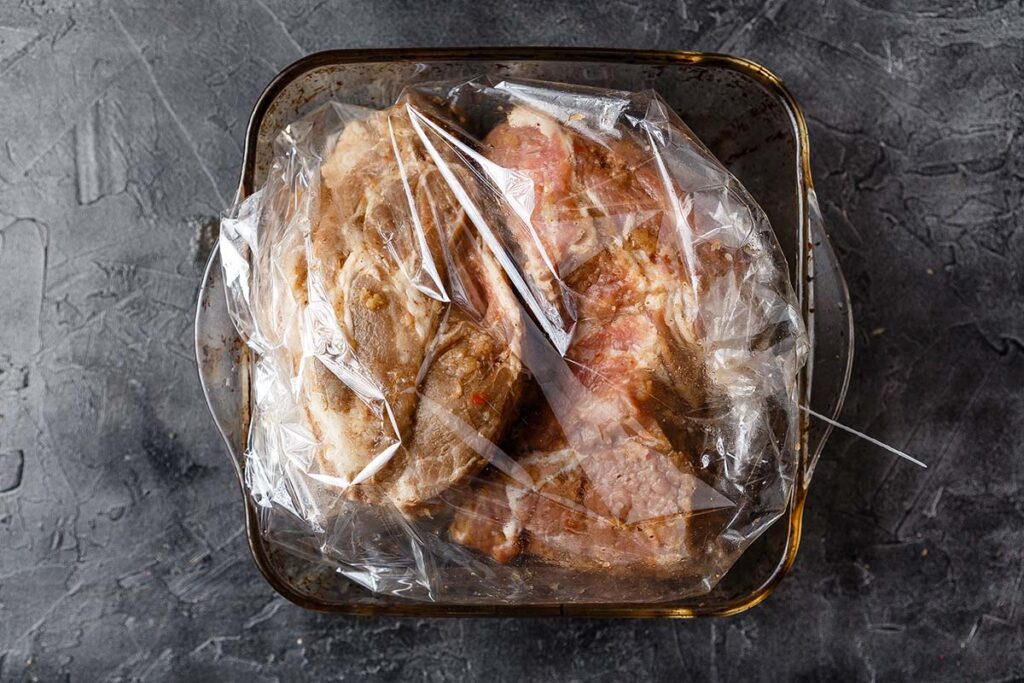
How to make a marinade?
A good marinade can make all the difference in a dish. It can add depth of flavor, tenderize tough meats, and infuse vegetables with a robust savoriness. But how do you create a marinade that will transform your meal from ordinary to extraordinary?
There are many different ways to make a marinade, but the basic ingredients are always the same: an acid, oil, herbs, or spices. The key is to strike the right balance of acidity, sweetness, and spices.
- Vinegar or lemon juice provides acidity, which helps to break down the tough fibers in the meat and enhance the flavor of vegetables.
- The oil helps to keep the food moist, and the herbs or spices add flavor.
- Sugar or honey balances out the acidity with a touch of sweetness, while herbs and spices add layers of flavor.
Ingredients for basic marinade:
- ¼ cup vinegar or lemon juice
- ¼ cup oil
- 1 tablespoon sugar or honey
- 1 teaspoon salt
- ½ teaspoon black pepper
- ¼ teaspoon dried thyme, basil, or oregano (optional)
Instructions:
1. whisk all the ingredients together in a bowl.
2. Place the food you want to marinate in a resealable bag or container, and pour in the marinade.
3. Make sure the food is well coated with the marinade, then seal the bag or container and refrigerate for at least 1 hour, up to 24 hours.
4. When you're ready to cook, remove the food from the marinade and discard the marinade.
5. Cook the food as desired.
To create your own signature marinade, experiment with different combinations of ingredients until you find a blend you love. With a bit of time and effort, you can easily create a marinade that will take your cuisine to the next level.
When should you use a marinade
A marinade is a great way to add flavor and moisture to meats, poultry, and seafood. The marinade's acidity helps break down tough muscles, making the meat more tender. In addition, the marinade can help to seal in juices, preventing the meat from drying out during cooking.
As a result, a well-chosen marinade can make all the difference in the final dish. When selecting a marinade, choosing one that complements the other flavors in the dish is crucial.
You can make marinades ahead of time and store them in the fridge for up to two days.
- For best results, marinate chicken for at least four hours
- Beef for at least eight hours
- Pork for at least 12 hours.
- Fish only needs to be marinated for 30 minutes to one hour.
When you're ready to cook, remove the meat from the marinade and cook it according to your recipe. Or, if you're short on time, you can cook the meat right in the marinade. Just bring it to a boil first to kill any bacteria.
How long should you leave food in a marinade
When it comes to marinating meat, there are two schools of thought. Some people believe that the longer the food is in the marinade, the more flavor it will absorb. Others believe that marinating for too long can make the food taste unpleasant.
So, how long should you leave food in a marinade?
Several factors determine the answer, including the type of food you're marinating and the ingredients in your marinade. If you're using a highly acidic marinade (such as one made with vinegar or lemon juice), it's best to keep the time to a minimum.
Otherwise, the acid may start to break down the proteins in the food, making it tough and unpleasant to eat. For most other types of marinades, however, you can safely marinate for up to 24 hours. Just be sure to keep the food refrigerated while it's marinating.
So, there's no need to worry about over-marinating your food. Just use your best judgment, and you'll be sure to create a delicious dish!
Note: There's no hard and fast rule for how long to marinate food, but generally, the longer you marinate, the more flavor your food will have. If you're in a hurry, you can marinate for as little as 30 minutes.
However, for best results, it's best to marinate for at least two hours or even overnight. The key is to experiment and find what works best for you. With a little trial and error, you'll soon be a pro at marinating food!
What are the benefits of using a marinade?
A marinade is a sauce, usually made with oil, vinegar, and spices, in which you soak food before cooking it. The most common use of marinades is on meat, fish, or vegetables.
The purpose of a marinade is to add flavor and tenderize the food. It can enhance the flavor of a dish. By soaking the food in a marinade, the flavors have a chance to penetrate deep into the food.
In addition, many marinades contain acidic ingredients, such as vinegar or lemon juice. These acids can help to break down tough fibers, making the food more tender. As a result, using a marinade can be a great way to boost the flavor and tenderness of your food.
There are many benefits to using a marinade, including the following:
1 Marinade can help to break down tough fibers in meat, making it more tender and flavorful.
2 A marinade's acids can help denature proteins, producing a juicier final product.
3 A marinade's oils can help seal moisture, resulting in a moist and juicy steak or chicken breast.
4 Marinades can add depth of flavor to meat, making it more exciting and delicious.
5 Marinades can be used as a base for sauces or gravies, adding even more flavor to your dish.
Consider using a marinade if you're looking for ways to add more flavor and tenderness to your meat dishes. With so many benefits, it's an easy and delicious way to upgrade your meal!
What are the best meats to marinate?
Not all meats have to be marinated. Take a large joint, for example. A marinade only gets absorbed into the outer surface, so the flavor doesn't penetrate deep into the flesh.
1 Some cuts of meat like ribeye and T-bones are juicy, tender enough in their own right, and do not require marinating. If you do marinate them, you can do more harm than good.
- Note: Bearing in mind that marinades add flavor, they are best used with meats with less strong tastes - we're talking here about chicken breasts and pork chops or beef cuts such as flank or skirt, which, if not marinated, tend to be tougher.
To get the most out of a marinade, it's best to use it on smaller, thinner cuts of meat such as beef, chicken, lamb, pork, and veal. These smaller cuts only require marinating for around 2 hours which is plenty of time to absorb the marinade.
2 Larger cuts like whole chickens can be left to marinate for up to 2 days, while joints of beef, lamb, pork, and veal can be left for up to 4 days. When you use an acidic marinade on fish and seafood, you will find that the food turns pale and become a little firmer because they are, in fact, "cooking."
However, please note that marinated seafood still needs to be cooked to the recommended internal temperatures.
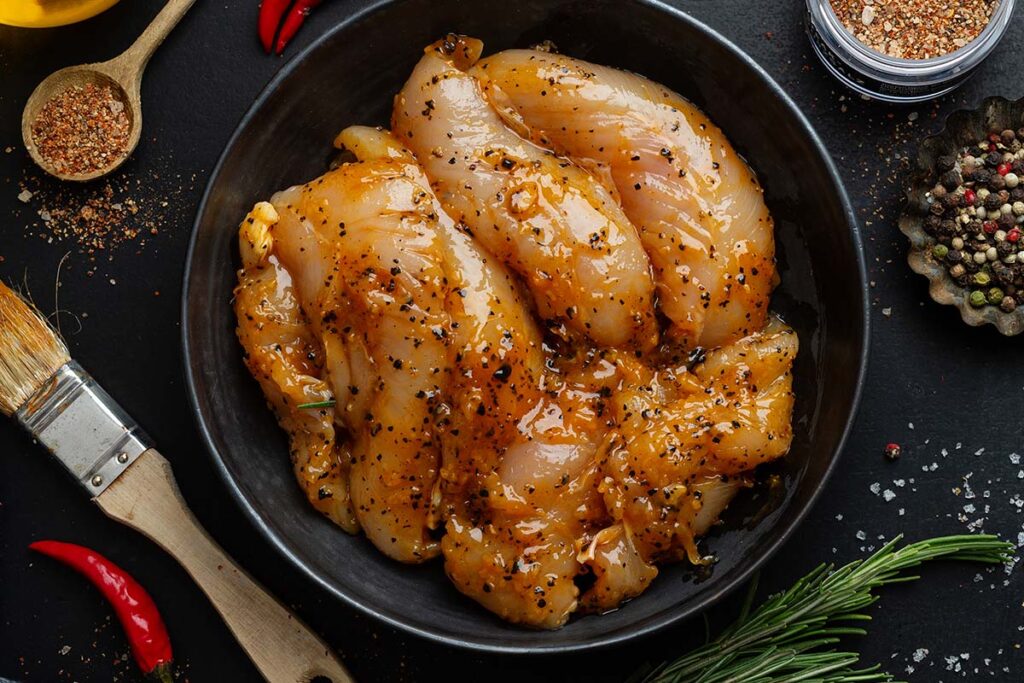
3 Veggies can be successfully marinated, though it tends to work best with softer vegetables. Why not experiment with things like eggplant, green beans, mushrooms, peas, summer squash, and zucchini?
Read: How to tenderize tough meat
How to marinate meat
Follow these simple steps for successful meat marination.
1 Assemble your ingredients and mix them in a small, non-reactive bowl.
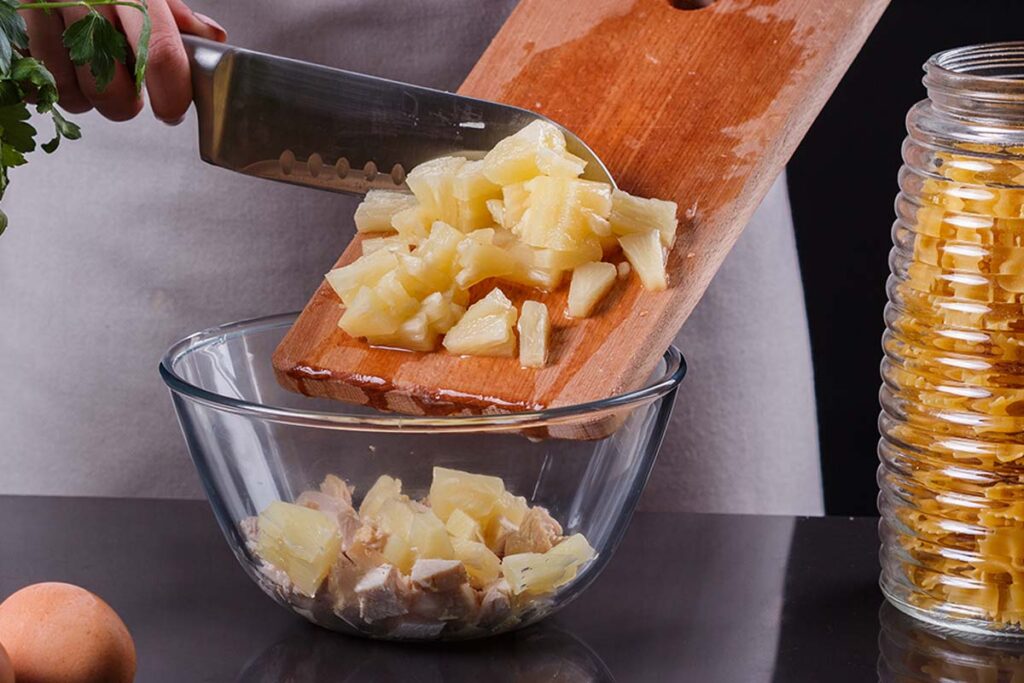
2 Transfer the meat into a large Ziploc bag. Pour the marinade over the meat inside the bag.
3 Close the Ziploc bag but leave a small gap so you can insert a straw, suck out as much air as possible, then extract the straw and complete the sealing of the bag in one swift motion.
4 Gently massage the marinade into the meat to ensure it is completely covered.
Note: If you are marinating vegetables, it's safer to carefully toss them inside the closed bag rather than massaging them as you could break them.
5 Position the bag in a bowl or tray to catch any leaks. Store it in the fridge for the recommended time.
Read: Marinate frozen chicken
A basic marinade recipe
The ingredients listed below will make you a good basic marinade that will work well with most meats and veggies depending on the options you choose from the ones I've listed.
- An acid using one or a combination of citrus juice, vinegar, wine, or yogurt
- Aromatic enhancers such as garlic, ginger, onion, and shallots
- A choice of herbs and spices from things like cinnamon, cumin, cloves, oregano, or rosemary
- Hot spices such as chili peppers, red pepper flakes, or Tabasco sauce
- Oil - olive oil or vegetable oil will both be suitable.
- Saltiness by way of salt, soy sauce, or Worcestershire sauce
To recap on something I said earlier, about what proportion-wise, allow ¼ of a cup of marinade for each pound of food you intend to marinade
You can try combinations of the abovementioned ingredients to give marinades for various meat and veggies.
If you'd like to sample something different, look at this Italian marinade on the nytimes.com website.
Remember - food safety and hygiene comes first.
When you're playing around with food, it's important to work safely and hygienically.
You must marinate your foods in your refrigerator. I know that your marinate is likely to have one or more of the acids I recommended, but that will not prevent the growth of unwanted bacteria if the food is left out at room temperature for too long.
Keep it in your fridge and under a constant 40°F. It's also a good idea to place the tray at the bottom of the fridge if there are any leaks. You don't want to spoil other foods in the refrigerator.
Tips on marinating meat
1 Don't let your marinade come into contact with any reactive metal - an aluminum tray, for example. It will set off a chemical reaction with the marinade, which will add an unpleasant taste and may also affect the color.
2 If you are marinating meat, discard the marinade once you're finished with it.
3 Whether you decide to wet or dry brine your meats or marinate them, you're sure to be delighted at how succulent the finished cooked product is and how tasty too.
If you've not tried any of these methods yet, make a note to do so. There's no excuse not to, as we've been over everything you need to know. Try it once, and I'm sure you'll do it again and again.


